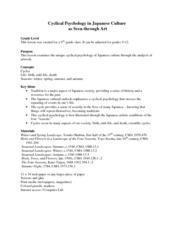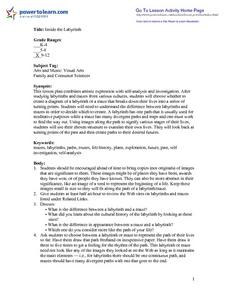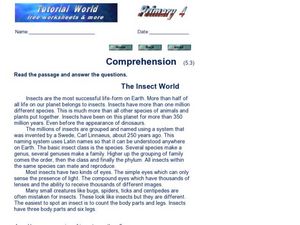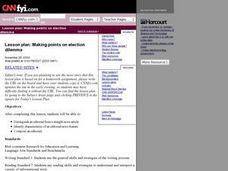Curated OER
Earth: the Apple of Our Eye
Students dissect an apple to model the percentage of land on Earth that can be used as a food-producing resource. They use fractions to determine the habitable and agriculture area of the apple.
Curated OER
Cyclical Psychology in Japanese Culture
Learners create artistic representations of various cyclical patterns after analyzing the importance of cyclical psychology in Japanese culture. This lesson can be done in an Art class or as part of a unit in a History or Language Arts...
Curated OER
Science: Dissolved Oxygen and Water Quality Sampling
Students perform tests to determine the level of oxygen dissolved in water. After examining a table displaying the temperature and solubility of water, they examine the three stages involved in the test. Upon completion, students explain...
Curated OER
From These Beginnings
Students prepare a bulletin board that shows the changing identity of their state before and after statehood.
Curated OER
Optional Laboratory: Soil Particle Size and Texture
Students work together to perform experiments on different types of soil. They record the soil's pH level, color and texture. They develop hypothesis' on what they believe they will discover before beginning the experiment.
Curated OER
The Fossil Record
Students research about the animals found in Burgess Shale. In this earth science lesson, students evaluate the significance of fossils in human history. They create models of their chosen animal.
Curated OER
Oregon City: A Convergence of Endings
Students describe the activities that occurred in the Willamette Valley before the establishment of the Oregon Trail and agricultural settlement and explain the impact that American settlement had on the landscape and native groups who...
Curated OER
What's Hatching in Kindergarten?
Students identify oviparous animals. They brainstorm a list of animals that lay eggs, read "Chickens Aren't The Only Ones" by Ruth Heller and then add to the list. Students complete a booklet that shows an egg and an oviparous animal.
Curated OER
The African Elephant: Reading Comprehension
In this comprehension worksheet, students read a short paragraph about the African Elephant, then answer 5 multiple choice questions. Answers provided.
Curated OER
Aboriginal Physical Education
Students engage in p.e. activities that have roots in native Indian, Metis, and Inuit cultures. They practice the skill involved and listen to the significance behind the skill. They read relevant books and define new terminology.
Curated OER
Estuarine Currents
Students explore an estuarine system to gather data on density driven currents. This type of current is contrasted with temperature and wind driven currents.
Curated OER
Science: Breathing in Space
Students determine the amount of air they use during rest and activity. They conduct experiments to calculate the number of breaths needed to empty a jug of water by exhaling through a tube into the container. Then, they figure how much...
Curated OER
Analyzing Japanese Imperialism
Students engage in a lesson in order to compare and contrast the Imperialism of Japan to that of the United States and Europe. Students can complete a variety of activities that include research questions, reflection from lecture, and...
Curated OER
City Bound
Fifth graders identify the reasons for people migrating to cities after the Civil War. Using population data, they discover why populations in cities rose while rural populations fell during 1860 to 1900. They discuss the impact a...
Curated OER
Jobs Past and Present
Students discover how jobs have changed from the past to today. In groups, they identify the varoius tools and resources used both in the past and today and discuss how they are different. As a class, they discuss the impact of the...
Curated OER
Inside the Labryinth
Students create a diagram of a labyrinth or a maze using information from their lives. As a class, students discuss the significant features and differences between a labryinth and a maze. They create the the twists and turns of the...
Curated OER
Why do people write?
Students brainstorm how and why people use writing in their
everyday lives and record answers on chart paper. They create a survey of questions in the computer lab then chart the responses they received from the survey then discuss the...
Curated OER
Reading Comprehension: The Insect World
In this comprehension worksheet, students read a non-fiction passage titled, "The Insect World" and complete 5 short answer questions.
Curated OER
Mixed Prepositions 12-ESL
In this preposition worksheet, students complete a given text, choosing the correct prepositions. Students click on a "check answers" button for immediate feedback.
Curated OER
Cell Theory, Plant And Animal Cell Comparison
Tenth graders study plant and animal cells. In this investigative lesson students draw their own animal cells and label them.
Curated OER
Make an Edible Coral Reef
Young scholars create an edible coral reef out of food and candy. In this Science lesson, students explore what a coral reef is and the coral reef's importance to the ecosystem. Additionally, young scholars discover the different parts...
Curated OER
Mitosis and Meiosis
Students model and differentiate between the processes of mitosis and meiosis. In partners, they use yarn and construction paper to create models for each of the phases of mitosis and meiosis then compare the chromosome numbers in each...
Curated OER
Making Points on Election Dilemma
Students define a straight news article, and identify characteristics of an editorial news feature. They read a CNN article that examines the 2000 presidential election, and determine what is factual and what is opinion.
Other popular searches
- Radioactivity Half Life
- Half Life Problems
- Half Life Radiometric Dating
- Radioactive Half Life
- Half Life Calculations
- Nuclear Chemistry Half Life
- Half Life Problems
- Half Life of Isotopes
- Nuclear Half Life
- Modeling Half Life
- Calculating Half Life
- Radioactive Half Life

























